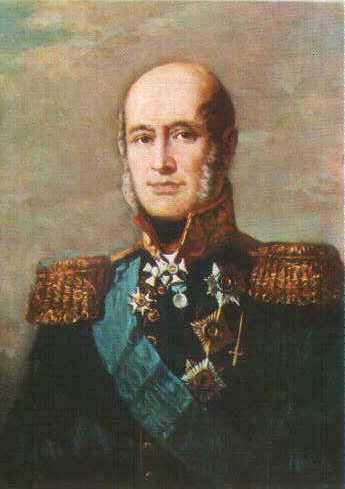It was 1812... Life in France and Russia was on its normal course. In Paris and St.Petersburg many state receptions and luxurious balls were given as usual. And as usual in many Russian towns, merchants were trading in hemp and fat. In villages, serfs were working hard in the country estates as before.
However, behind this very usual-seeming way of life, the first remote but disturbing rumblings of the coming thunderstorm of war were heard. From France to the Oder and then to the Vistula and the Niemen the long trains of troops were moving: Cavalry, infantry, artillery - great number of carriages with food and ammunition - the huge mass moved along many roads. Napoleon and his large retinue followed the army moving to the Niemen river. On May 16th, he entered Dresden, where he stayed for two weeks, receiving the Prussian and Saxon Kings and the Emperor of Austria. On May,29th he left Dresden and went through Glogay, Poznan, and Danzig to Kovno.
Tsar Alexander the Ist had come Vilno a month earlier. He had felt the coming storm and brought his retinue and military counselors to inspect the army. At last, on the day of Alexander's leaving, Chancellor Rumyantsev said to French ambassador Lauriston that Russia did not want war and was ready to do anything to avoid it. That the Tsar went to Vilno only because of the French troops approaching the frontier of Russia, and that he was worried that some incident might cause the breaking-off of diplomatic relations with France and the beginning of war.
Perhaps, by this visit Alexander wanted to reassure uneasy nobles (and Napoleon) that he would resist any invasion with all possible strength. Before the beginning of the war the Russian troops consigned to the defense of the Western frontier numbered only about 230 thousand men, formed into three armies, scattered along a span of nearly one thousand kilometers. The 1st Army of Barclay de Tolly (130 thousand men and 550 guns) protected the Approaches to St.Petersburg; the 2nd Army of Bagration (45 thousand men and 270 guns) - the approaches to Moscow, and the 3rd (reserve) Army of Tormasov (46 thousand men and 168 guns) - the approaches to Kiev.
As politics have always influenced developing strategic plans, so the Russian government, knowing of Napoleon's military preparations, made a number of very different suppositions. Initially in 1811, the plan of a preventive war appeared. This was connected with a foreseen opportunity of an alliance with Austria and the Duchy of Warsaw.(1) But when it turned out these covenants were impossible, the Russians began to develop the defensive plan. (2)
 Michail Bogdanovich Barclay de Tolly
Michail Bogdanovich Barclay de Tolly
|
But Barclay de Tolly, who was the War Minister and the Commander of the 1st Army, did not share such views. He was sure they had to keep to defenses as they saw prudent, depending on Napoleon's military operations.
The approach to St.Petersburg was considered the most important of three directions (to St.Petersburg,Moscow, and Kiev). And the main Russian forces and rear organizations were accordingly disposed. (5)
Besides the strategic plan, the operational plan was developed. The author; General Phuel, the former counselor of the Prussian King who came to Russia after the defeat of Prussia in 1806. He was an admirer of the then very popular theory of Buhlov, and ignored the crushing of the Prussian troops by Napoleon at Jena and Auerstedt. He proposed to make a fortified encampment on the main approach to St.Petersburg near the town of Drissa. The 1st army supported by this would have to attract the main forces of Napoleon and at the same time the 2nd and 3rd armies would strike blows on the flank and rear of the advancing French troops. Alexander I accepted this proposal because he saw in it a kind of realization of Barclay de Tolly's strategic plan.
The Tsar and his retinue proceeded on the assumption that Napoleon would invade Russia with the army of 200 thousand, as it was in 1806-1807. But Barclay de Tolly didn't share this opinion at all. He wrote to Alexander : "I don't understand what we will do with all our army in the Drissa camp". (6)
From the information received by the Russian General Staff, it appeared Napoleon was preparing much more serious action, so Barclay tried to bring the 2nd and 1st armies together to prevent Napoleon from defeating them one by one.
Actually, the plan of Napoleon was even more purposeful. He considered the main operational thrust would be to Moscow and not to St.Petersburg. The capture of St.Petersburg, the political centre of Russia, could not decide the outcome of the war, but the seizure of Moscow would achieve the main task - the capture of the economic centre of the state feeding the army, and it would make possible the blockade of St.Petersburg. "If I capture Kiev" said Napoleon, "I'll take its feet" "If I capture St.Petersburg - I'll seize its head, but if I capture Moscow - I'll hit its heart" (7)
1. F.Martens. Collection of treaties and conventions. Volume VII. St.Petersburg, 1885, p.25-37
2. "Military Journal", 1859, N 1, part IV,p.3
3. "General Bagration" Collection of materials and documents. Moscow, 1945, p.153
4. L.L.Bennigsen "Letters About The War of 1812", Kiev, 1912, p.16
5. "Military Journal",1859, N 1, part IV, p.2-4
6. A.N.Popov. "Episodes Of The History Of 1812", "Russian Archive", 1892, Volume IV, p.431
7. A.Baiov "The Course of The History of Military Art", issue VII, St.Petersburg, 1913, p.390